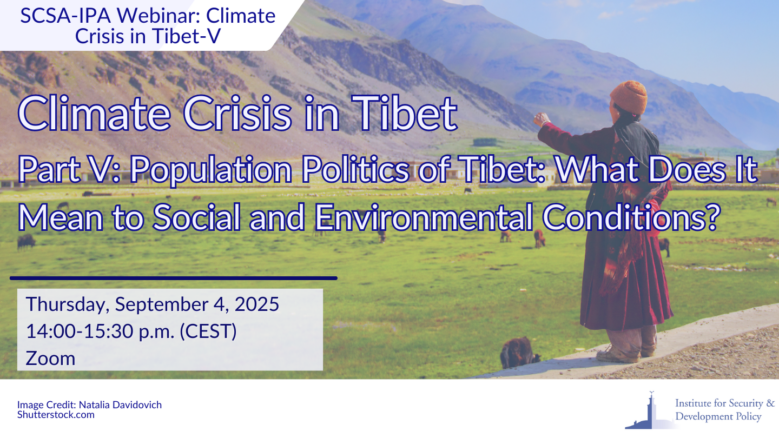Climate Crisis in Tibet – Part V: Population Politics of Tibet: What Does It Mean to Social and Environmental Conditions?

Did you miss this webinar? The full recording is available on ISDP’s YouTube channel.
China’s long-term strategy for Tibet through 2049 reveals a comprehensive and multi-dimensional approach aimed at fully integrating Tibet into the Chinese nation-state. This marks a decisive shift from the earlier framework of ‘nominal autonomy’, which had provided some space for the protection of Tibetan language and culture. The current trajectory prioritizes urbanization and assimilation, gradually reducing Tibetans to one among many ethnic groups within urban municipalities, where no group retains distinct rights. As a result, many Tibetans are being displaced and relocated to frontier settlements or high-density concrete housing. Further, the Chinese authorities have tightened their grip on Tibetans’ lives through intensive surveillance, border control, and restrictions on movement.
A key turning point came with the 2006 opening of the Qinghai-Tibet railway, which significantly increased access to the region for Han Chinese migrants. Beijing framed this development as an effort to “bring Tibet closer to China,” but it has effectively accelerated the sinicization of Tibetan society. The government has actively facilitated Han migration into Tibetan areas, transforming the cultural and demographic landscape. This population shift is accompanied by large-scale relocations of Tibetan villages—moves that Human Rights Watch and others have described as effectively compulsory, despite official claims of voluntary participation.
Tibetan farmers, removed from traditional lands and practices, find themselves reduced to wage laborers, disconnected from their historical relationship with the environment. Between 2000 and 2025, an estimated 930,000 rural Tibetans were displaced due to a variety of reasons, ranging from large-scale infrastructure works to government policies designed to end nomadic pastoral lifestyles. In this same period, 3.36 million rural Tibetans–roughly half of the entire population–were impacted by policies requiring them to rebuild their houses or abandon nomadic life, even if not formally relocated. The loss of traditional livelihoods has created a widespread dependency on state subsidies. Some Tibetans have experienced multiple relocations across this period. Most notably, 76 percent of these relocations have occurred since 2016 under Xi Jinping’s leadership, indicating a significant escalation of Beijing’s control efforts. The displacement of Tibetans from nomadic pastoral lifestyles is especially problematic as it increases urbanization across Tibet, as well as energy needs and consumption.
The vacated areas frequently become sites for intensive resource extraction, such as mining operations for oil, copper, gold, and gas, that further weaken soil integrity and accelerate temperature increases. These activities have corresponded with rising incidences of landslides, glacial lake outbursts, and other ostensibly “natural” disasters that have anthropogenic origins. China’s extensive infrastructure development in Tibet proceeds with minimal regard for environmental impact. While positioned as economic advancement, these projects prioritize strategic interests and resource extraction rather than addressing local poverty and unemployment, and evidence suggests Tibet’s delicate ecological equilibrium faces severe disruption.
Concurrently, Tibetans face cultural erasure. Despite the official “Bilingual Education Policy,” Mandarin Chinese is increasingly dominant in schools, with Han Chinese teachers, many of whom do not speak Tibetan, serving as the primary educators. Tibetan language instruction is being systematically reduced. State-run boarding schools further remove children from their families, communities, and cultural context, reinforcing efforts to assimilate Tibetan youth into Han norms and identity. Beijing’s policies aim to subjugate Tibetan Buddhism by promoting cultural assimilation and suppressing Tibetan identity under the guise of modernization.
In response to these policies, on July 12, 2024, U.S. President Joe Biden signed the Resolve Tibet Act, affirming that China’s actions are systematically suppressing Tibetans’ ability to maintain their cultural identity and traditional way of life. The Act reaffirms U.S. support for the human rights of Tibetans and the preservation of their unique linguistic, cultural, and religious heritage. In sum, Beijing’s population politics support its high-modernist development approach, which privileges modernization and industrialization over indigenous rights and environmental protection.
The fifth in a series, this webinar will explore and attempt to address the following questions with leading experts on the subject:
- What are the main goals behind China’s population and urbanization policies in Tibet, and how do they reflect broader state interests in national integration and territorial control?
- How have infrastructure developments facilitated demographic shifts in Tibet, and what are the social and cultural consequences of increased Han migration into the region?
- To what extent can the relocation of Tibetan villagers and the erosion of nomadic pastoral lifestyles be seen as forced assimilation rather than development or modernization?
- How does the reduction of Tibetan language instruction and the rise of state-run boarding schools’ impact intergenerational cultural transmission and identity formation among Tibetan youth?
- How are the Tibetan people coping? Has there been any pushback or is there little recourse?
- What are the environmental consequences of China’s policies and how are they connected to broader patterns of displacement and urbanization?
- What is the scope of China’s development plans going forward, given the focus on industrial growth and resource extraction in Tibet?
- How might the U.S. Resolve Tibet Act influence international discourse on Tibet and China’s internal policies? Is it likely to have a material impact, or is its significance primarily symbolic?
- What role should the international community play in addressing the social, cultural, and environmental consequences of China’s population policies in Tibet? What strategies might be both effective and respectful of Tibetan agency?
Speakers:
 Dr. Jarmila Ptáčková is a research fellow at the Oriental Institute of the Czech Academy of Sciences. She earned her degree in Chinese studies and a PhD in Tibetan studies at the Humboldt University in Berlin. Among her research interests are Chinese development policy and subsequent social and economic changes in Tibetan areas, China’s ethnic policy, and China’s territorialisation of the Himalayan frontier and the role of Tibetans in PRC’s cultural and economic diplomacy towards Nepal.
Dr. Jarmila Ptáčková is a research fellow at the Oriental Institute of the Czech Academy of Sciences. She earned her degree in Chinese studies and a PhD in Tibetan studies at the Humboldt University in Berlin. Among her research interests are Chinese development policy and subsequent social and economic changes in Tibetan areas, China’s ethnic policy, and China’s territorialisation of the Himalayan frontier and the role of Tibetans in PRC’s cultural and economic diplomacy towards Nepal.
 Dr. Anton Harder is an international historian of China and India. He is currently completing a book to be published by Oxford University Press on Sino-Indian relations in the early Cold War. At the London School of Economics he teaches the international history of Asia and the world. Anton likes to approach international issues from a China-India perspective. He consults to think-tanks and companies in Europe and maintains a blog.
Dr. Anton Harder is an international historian of China and India. He is currently completing a book to be published by Oxford University Press on Sino-Indian relations in the early Cold War. At the London School of Economics he teaches the international history of Asia and the world. Anton likes to approach international issues from a China-India perspective. He consults to think-tanks and companies in Europe and maintains a blog.
 Mr. Kalpit A. Mankikar is a China Fellow with the Observer Research Foundation’s (ORF) Strategic Studies Programme. He completed his China Studies master’s degree from the London School of Economics. He has degrees in journalism and political science from the Asian College of Journalism and the University of Mumbai, respectively. He co-edited a book titled ‘Sino-Indian Ties Under Modi: Rising to the China Challenge’ in 2024. He has contributed articles for Foreign Affairs, the Stimson Center’s ‘South Asia Voices’, the Lennart Meri Conference, Hindustan Times, and The Hindu. He worked as a media professional for nearly two decades with leading publications like The Times of India, Daily News and Analysis.
Mr. Kalpit A. Mankikar is a China Fellow with the Observer Research Foundation’s (ORF) Strategic Studies Programme. He completed his China Studies master’s degree from the London School of Economics. He has degrees in journalism and political science from the Asian College of Journalism and the University of Mumbai, respectively. He co-edited a book titled ‘Sino-Indian Ties Under Modi: Rising to the China Challenge’ in 2024. He has contributed articles for Foreign Affairs, the Stimson Center’s ‘South Asia Voices’, the Lennart Meri Conference, Hindustan Times, and The Hindu. He worked as a media professional for nearly two decades with leading publications like The Times of India, Daily News and Analysis.
 Carole McGranahan is a professor of anthropology and history at the University of Colorado, USA. Her research is about 20th and 21st Tibet, including the Chushi Gangdrug resistance army; American, British, and Chinese empires in Tibet; self-immolation inside Tibet; and asylum, refusal, and refugee citizenship in the Tibetan diaspora (Canada, India, Nepal, USA). She is author of numerous books and articles, including Arrested Histories: Tibet, the CIA, and Memories of a Forgotten War (2010), co-editor of Imperial Formations (2007) and Ethnographies of U.S. Empire (2018), editor ofWriting Anthropology: Essays on Craft and Commitment(2020), and co-editor of the forthcoming The Tibet Reader.
Carole McGranahan is a professor of anthropology and history at the University of Colorado, USA. Her research is about 20th and 21st Tibet, including the Chushi Gangdrug resistance army; American, British, and Chinese empires in Tibet; self-immolation inside Tibet; and asylum, refusal, and refugee citizenship in the Tibetan diaspora (Canada, India, Nepal, USA). She is author of numerous books and articles, including Arrested Histories: Tibet, the CIA, and Memories of a Forgotten War (2010), co-editor of Imperial Formations (2007) and Ethnographies of U.S. Empire (2018), editor ofWriting Anthropology: Essays on Craft and Commitment(2020), and co-editor of the forthcoming The Tibet Reader.
Moderator:
 Dr. Jagannath Panda is the Head of the Stockholm Center for South Asian and Indo-Pacific Affairs (SCSA-IPA) at the Institute for Security and Development Policy (ISDP), Sweden. Dr. Panda is also a Professor at the Department of Regional and Global Studies at the University of Warsaw; and a Senior Fellow at The Hague Center for Strategic Studies in the Netherlands. As a senior expert on China, East Asia, and Indo-Pacific affairs, Prof. Panda has testified to the US-China Economic and Security Review Commission at the US Congress on ‘China and South Asia’. He is the Series Editor for Routledge Studies on Think Asia.
Dr. Jagannath Panda is the Head of the Stockholm Center for South Asian and Indo-Pacific Affairs (SCSA-IPA) at the Institute for Security and Development Policy (ISDP), Sweden. Dr. Panda is also a Professor at the Department of Regional and Global Studies at the University of Warsaw; and a Senior Fellow at The Hague Center for Strategic Studies in the Netherlands. As a senior expert on China, East Asia, and Indo-Pacific affairs, Prof. Panda has testified to the US-China Economic and Security Review Commission at the US Congress on ‘China and South Asia’. He is the Series Editor for Routledge Studies on Think Asia.